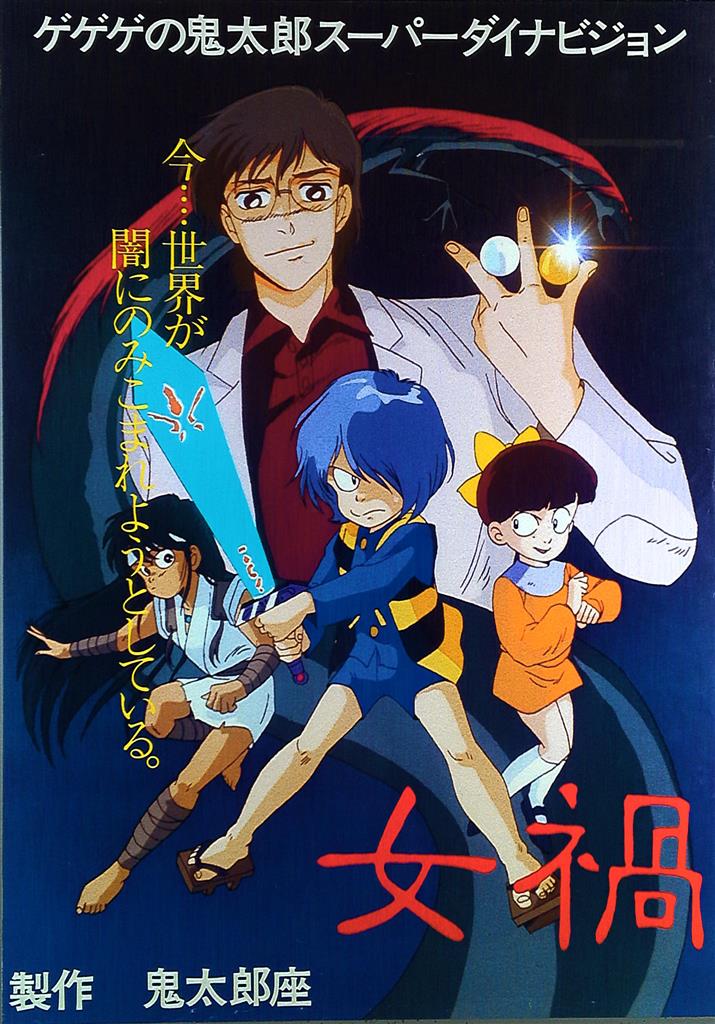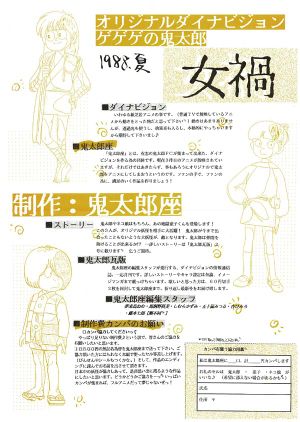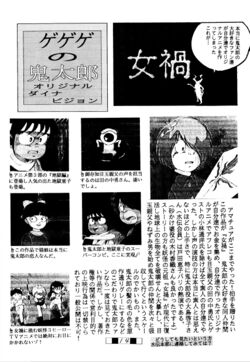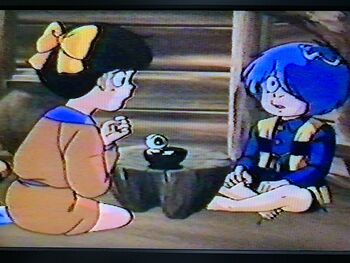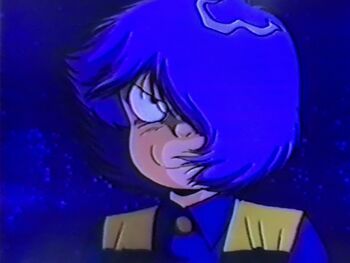Joka (lost animated fan film based on anime series; 1989): Difference between revisions
BloodyBobby (talk | contribs) (I need to come back and work on some other parts, but I think this is good for now considering this hasn't been updated for a few years ^^;) |
|||
| (3 intermediate revisions by 2 users not shown) | |||
| Line 5: | Line 5: | ||
|status=<span style="color:red;">'''Lost'''</span> | |status=<span style="color:red;">'''Lost'''</span> | ||
}} | }} | ||
'''''Gegege no Kitaro (ゲゲゲの鬼太郎)''''' is a multimedia franchise created by author Shigeru Mizuki. Although relatively unknown in the West, ''Gegege no Kitaro'' is extremely popular in Japan, | '''''Gegege no Kitaro (ゲゲゲの鬼太郎)''''' is a multimedia franchise created by manga author Shigeru Mizuki. Although relatively unknown in the West, ''Gegege no Kitaro'' is extremely popular in Japan, and has an array of multiple different video games, feature films, and anime. In 1989, the Japanese doujin group "Kitaroza" (鬼太郎座) produced an unofficial film based on the series, titled ''(女禍, Joka, also known as Jo-Ka)''. This small group of fans specialized in making self-published manga (known as doujinshi) specifically based on the 1985 ''Gegege no Kitaro'' anime. Despite the films limited animation, it was reported that the quality was phenomenal for a fan project, as many industry professionals were involved in its production. '''''Although VHS copies of the film have circulated among fans, the film remains lost.''''' | ||
[[File:Joka_News.jpg|thumb|right|An image taken from an unknown publication. The run-time for the film is listed at roughly 30 minutes.]] | |||
==Background== | |||
The film's run time was approximately 30 minutes. It was animated using a technique known as "Dynavision", in which cels were projected in a slide-show manner, with sound effects and light projections used to give the illusion of movement.<ref name="SG">[http://www.lamoonbatake.net/main/museum/books/story/joka/joka_story_sp.html Behind the Scenes information about the film ''Joka''.] Retrieved 10 Oct '20</ref> Details about the soundtrack are unknown; However, the film had an ending theme sung by the artist MIQ (also known as MIO) titled "月読幻想" (lit. Moon Reading Fantasy).<ref>[https://www.youtube.com/watch?v=BgBoeTN6wCc Video of the singer MIQ discussing her involvement on the films score.] Retrieved 16 Dec '23</ref> MIQ has sung the opening and closing songs for anime such as "Heavy Metal L-Gaim" and "Xabungle". | |||
Shigeru Mizuki gave permission for the artists and crew involved to use his characters, and was present to witness a screening of the film. Isamu Tanonaka also returned to voice Kitaro's father, Medama Oyaji. <ref name="SG"/> | |||
The film was screened privately on March of 1989 at an event known as "Yokai Champon" (妖怪ちゃんぽん).<ref>[https://www.lamoonbatake.net/main/museum/rekisi/kitarouza/kitaroza.html Information about the doujin group "Kitaroza".] Retrieved 16 Dec '23</ref> It's unknown how many times the film was screened outside of this event; However, Wikipedia lists the film as having only one screening. Shortly after ''Joka'' was screened, "Kitaroza" disbanded, though many of the original members would work together on future projects. | |||
==Plot== | ==Plot== | ||
[[File:Joka Flyer.jpg|thumb|right|A pamphlet given out during a private screening. Some characters, such as Neko-Musume, were given a slight redesign for the film.]] | [[File:Joka Flyer.jpg|thumb|right|A pamphlet given out during a private screening. Some characters, such as Neko-Musume, were given a slight redesign for the film.]] | ||
The film takes place after the events of the third ''Gegege no Kitaro'' anime series. Characters from the third anime are featured, although the female protagonist | The film takes place after the events of the third ''Gegege no Kitaro'' anime series. Characters from the third anime are featured, although the female protagonist "Yumeko" is no longer present.<ref>[https://twitter.com/yoshiwo2006/status/1086648789279027201 A tweet confirming that the character Yumeko does not appear in the film.] Retrieved 10 Oct '20</ref> Lost Media Wiki user "Robotkat" has graciously translated the plot of the film from "La Moon’s" official website (formerly "Kitaroza"), which has been provided in the External Links section. A basic plot summary is as follows: | ||
Jigoku-Doji returns to visit Kitaro, telling him of a human who has the ability to remove souls from the afterlife and put them through eternal suffering. This human is named Yasuda. Yasuda, who was once an archaeologist, was confused as to why there was little information about the God Tsukuyomi-no-Mikoto (月読尊) that he could find in his research. He soon discovers a piece of literature, stating that Tsukuyomi was the God who was responsible for creating | Jigoku-Doji returns to visit Kitaro, telling him of a human who has the ability to remove souls from the afterlife and put them through eternal suffering. This human is named Yasuda. Yasuda, who was once an archaeologist, was confused as to why there was little information about the God Tsukuyomi-no-Mikoto (月読尊) that he could find in his research. He soon discovers a piece of literature, stating that Tsukuyomi was the God who was responsible for creating Yokai. Yasuda stole five ancient orbs from the tomb of Tsukuyomi, using their powers to absorb souls in an attempt to resurrect the powerful God. | ||
One more sacrifice is needed to summon Tsukuyomi. Kitaro and his friends don’t believe Yasuda’s words, but are taken aback when one of the orbs lights up, absorbing Yasuda in a pillar of fire. | One more sacrifice is needed to summon Tsukuyomi. Kitaro and his friends don’t believe Yasuda’s words, but are taken aback when one of the orbs lights up, absorbing Yasuda in a pillar of fire. | ||
| Line 18: | Line 26: | ||
Suddenly, the Earth begins to crack and shake, and a powerful snake-like monster erupts from the ground. Medama-Oyami, Kitaro's father, immediately recognizes the creature as "Joka", a God of Chinese mythology. Tsukuyomi, as it turns out, was the Chinese God known as Joka. | Suddenly, the Earth begins to crack and shake, and a powerful snake-like monster erupts from the ground. Medama-Oyami, Kitaro's father, immediately recognizes the creature as "Joka", a God of Chinese mythology. Tsukuyomi, as it turns out, was the Chinese God known as Joka. | ||
Joka needs the energy of all of the | Joka needs the energy of all of the Yokai they’ve created to completely wake up. The creature starts absorbing Kitaro’s father, who can only look on helplessly as he is seriously injured. It’s up to Kitaro, Neko-Musume, and Jigoku-Doji to put a stop to Joka, and save not only their Yokai friends, but all of Japan.<ref>[http://www.lamoonbatake.net/main/museum/books/story/joka/joka_story1.html A brief plot summary of the film from the official website of La Moon (formerly Kitaroza).] Retrieved 11 Oct '20</ref> | ||
[[File: | [[File:Joka_ScreenS.jpg|thumb|right|250px|An article from the fanzine ''水木伝説 VOL 3'', containing information and images from the film.]] | ||
==Staff Members== | ==Staff Members== | ||
Thanks to a pamphlet given out during a screening of the film, we have insight as to who some of the staff and crew members were. Due to the | Thanks to a pamphlet given out during a screening of the film, we have insight as to who some of the staff and crew members were. Due to the films' unofficial nature, some staff members used pseudonyms, leaving their real identity a mystery. Their names are as follows: | ||
*Nemu Mukudori (夢来鳥ねむ) Co-Founder of | *Nemu Mukudori (夢来鳥ねむ) Co-Founder of Kitaroza, Voice of Neko Musume for the film.<ref name="SG"/> | ||
*Akara Arisato (有里紅良) Co-Founder of | *Akara Arisato (有里紅良) Co-Founder of Kitaroza | ||
*Isamu Tanonaka (田の中勇) Voice of Medama-Oyaji | *Isamu Tanonaka (田の中勇) Voice of Medama-Oyaji | ||
| Line 41: | Line 44: | ||
*Himura You (pseudonym) | *Himura You (pseudonym) | ||
*Satoru Iriyoshi (入好さとる) Animator on the Third ''Gegege no Kitaro'' Anime *rumored*<ref>[https:// | *Satoru Iriyoshi (入好さとる) Animator on the Third ''Gegege no Kitaro'' Anime *rumored*<ref>[https://archive.is/sMYPJ A tweet claiming that Animation Director Satoru Iriyoshi worked on the film ''Joka''.] Retrieved 10 Oct '20</ref> | ||
*Yoshihiro Takeda (たけだ欣弘) Key Animator for the Fourth ''Gegege no Kitaro'' Anime <ref>[https:// | *Yoshihiro Takeda (たけだ欣弘) Key Animator for the Fourth ''Gegege no Kitaro'' Anime <ref>[https://archive.is/3K6y5 A tweet by Yoshihiro Takeda, confirming he was involved with production of the film ''Joka''.] Retrieved 10 Oct '20</ref> | ||
==Availability== | ==Availability== | ||
Due to the film being fan-made, it's never received an official release of any kind. There's claims that some who were present at a private screening were able to obtain VHS copies,<ref>[https://twitter.com/haruishi_/status/1086658512812335104 A twitter user claiming to have once owned a copy of the film ''Joka''.] Retrieved 10 Oct '20</ref> though this wouldn't be confirmed until 2021. | |||
[[File:Joka Screenshot 04.JPG|thumb|right|Note the pause button on the bottom of the image, suggesting the film is being viewed from a computer.]] | |||
In 2021, renewed interest in the film began circulating among Japanese ''Gegege no Kitaro'' fans, when it was revealed that an anonymous user on Twitter owned a VHS copy of ''Joka''. When contacted, they apologized, stating that they were not granted permission to upload the film online. | |||
In August of 2022, Twitter user @yoshiwo2006 uploaded images from ''Joka'' onto their account in a series of Tweets.<ref>[https://web.archive.org/web/20220830144724/https://twitter.com/yoshiwo2006/status/1564583992275652609 Archived tweets from Twitter user @yoshiwo2006 containing screenshots of ''Joka''.] Retrieved 16 Dec '23</ref> It appeared that the film was being viewed on a computer, suggesting that a VHS copy may have been converted into a digital format. However, shortly after uploading these images, @yoshiwo2006 would delete these tweets and apologize. Thankfully, almost all of these images have since been recovered, and can be viewed in both the gallery section and among the external links. | |||
No doubt, ''Joka'' is safe somewhere among the hands of a collector. Whether due to copyright reasons or other unknown factors, those who own copies of the film are either unwilling to share it, or simply unable to. As of the time of writing, no actual footage has surfaced from the film. | |||
==Gallery== | |||
<gallery mode=packed heights=175px> | |||
Joka Screenshot 01.JPG | |||
Joka_Screenshot_02.jpg | |||
Joka Screenshot 03.JPG | |||
Joka_Titlecard.jpg|The title card of ''Joka'', posted by an anonymous user on Twitter. | |||
</gallery> | |||
==External Links== | ==External Links== | ||
*[https://www.docdroid.net/NbJgCZt/joka-pdf The plot summary of the film ''Joka'', graciously translated by Lost Media Wiki user RobotKat.] Retrieved 11 Oct '20 | *[https://www.docdroid.net/NbJgCZt/joka-pdf The plot summary of the film ''Joka'', graciously translated by Lost Media Wiki user RobotKat.] Retrieved 11 Oct '20 | ||
*[https://ja.wikipedia.org/wiki/有里紅良 Japanese Wikipedia link on co-founder of | *[https://ja.wikipedia.org/wiki/有里紅良 Japanese Wikipedia link on co-founder of "Kitaroza", Akara Arisato.] Retrieved 11 Oct '20 | ||
*[https://ja.wikipedia.org/wiki/夢来鳥ねむ Japanese Wikipedia link on co-founder of | *[https://ja.wikipedia.org/wiki/夢来鳥ねむ Japanese Wikipedia link on co-founder of "Kitaroza", Nemu Mukudori.] Retrieved 11 Oct '20 | ||
*[https://ja.wikipedia.org/wiki/ら・むうん Japanese Wikipedia link on "La Moon".] Retrieved 11 Oct '20 | *[https://ja.wikipedia.org/wiki/ら・むうん Japanese Wikipedia link on "La Moon" (formerly "Kitaroza").] Retrieved 11 Oct '20 | ||
*[http://www.lamoonbatake.net/top/index.html La Moon | *[http://www.lamoonbatake.net/top/index.html Official website of "La Moon" (formerly "Kitaroza").] Retrieved 11 Oct '20 | ||
*[https://archive.org/details/joka-screenshots-updated All ''Joka'' screenshots provided by Twitter user @yoshiwo2006.] Retrieved 16 Dec '23 | |||
==References== | ==References== | ||
Latest revision as of 04:45, 17 December 2023
Gegege no Kitaro (ゲゲゲの鬼太郎) is a multimedia franchise created by manga author Shigeru Mizuki. Although relatively unknown in the West, Gegege no Kitaro is extremely popular in Japan, and has an array of multiple different video games, feature films, and anime. In 1989, the Japanese doujin group "Kitaroza" (鬼太郎座) produced an unofficial film based on the series, titled (女禍, Joka, also known as Jo-Ka). This small group of fans specialized in making self-published manga (known as doujinshi) specifically based on the 1985 Gegege no Kitaro anime. Despite the films limited animation, it was reported that the quality was phenomenal for a fan project, as many industry professionals were involved in its production. Although VHS copies of the film have circulated among fans, the film remains lost.
Background
The film's run time was approximately 30 minutes. It was animated using a technique known as "Dynavision", in which cels were projected in a slide-show manner, with sound effects and light projections used to give the illusion of movement.[1] Details about the soundtrack are unknown; However, the film had an ending theme sung by the artist MIQ (also known as MIO) titled "月読幻想" (lit. Moon Reading Fantasy).[2] MIQ has sung the opening and closing songs for anime such as "Heavy Metal L-Gaim" and "Xabungle".
Shigeru Mizuki gave permission for the artists and crew involved to use his characters, and was present to witness a screening of the film. Isamu Tanonaka also returned to voice Kitaro's father, Medama Oyaji. [1]
The film was screened privately on March of 1989 at an event known as "Yokai Champon" (妖怪ちゃんぽん).[3] It's unknown how many times the film was screened outside of this event; However, Wikipedia lists the film as having only one screening. Shortly after Joka was screened, "Kitaroza" disbanded, though many of the original members would work together on future projects.
Plot
The film takes place after the events of the third Gegege no Kitaro anime series. Characters from the third anime are featured, although the female protagonist "Yumeko" is no longer present.[4] Lost Media Wiki user "Robotkat" has graciously translated the plot of the film from "La Moon’s" official website (formerly "Kitaroza"), which has been provided in the External Links section. A basic plot summary is as follows:
Jigoku-Doji returns to visit Kitaro, telling him of a human who has the ability to remove souls from the afterlife and put them through eternal suffering. This human is named Yasuda. Yasuda, who was once an archaeologist, was confused as to why there was little information about the God Tsukuyomi-no-Mikoto (月読尊) that he could find in his research. He soon discovers a piece of literature, stating that Tsukuyomi was the God who was responsible for creating Yokai. Yasuda stole five ancient orbs from the tomb of Tsukuyomi, using their powers to absorb souls in an attempt to resurrect the powerful God.
One more sacrifice is needed to summon Tsukuyomi. Kitaro and his friends don’t believe Yasuda’s words, but are taken aback when one of the orbs lights up, absorbing Yasuda in a pillar of fire.
Suddenly, the Earth begins to crack and shake, and a powerful snake-like monster erupts from the ground. Medama-Oyami, Kitaro's father, immediately recognizes the creature as "Joka", a God of Chinese mythology. Tsukuyomi, as it turns out, was the Chinese God known as Joka.
Joka needs the energy of all of the Yokai they’ve created to completely wake up. The creature starts absorbing Kitaro’s father, who can only look on helplessly as he is seriously injured. It’s up to Kitaro, Neko-Musume, and Jigoku-Doji to put a stop to Joka, and save not only their Yokai friends, but all of Japan.[5]
Staff Members
Thanks to a pamphlet given out during a screening of the film, we have insight as to who some of the staff and crew members were. Due to the films' unofficial nature, some staff members used pseudonyms, leaving their real identity a mystery. Their names are as follows:
- Nemu Mukudori (夢来鳥ねむ) Co-Founder of Kitaroza, Voice of Neko Musume for the film.[1]
- Akara Arisato (有里紅良) Co-Founder of Kitaroza
- Isamu Tanonaka (田の中勇) Voice of Medama-Oyaji
- Kazumi Shimura (possible pseudonym)
- Mitsuru Gojitsu (pseudonym)
- Himura You (pseudonym)
- Satoru Iriyoshi (入好さとる) Animator on the Third Gegege no Kitaro Anime *rumored*[6]
- Yoshihiro Takeda (たけだ欣弘) Key Animator for the Fourth Gegege no Kitaro Anime [7]
Availability
Due to the film being fan-made, it's never received an official release of any kind. There's claims that some who were present at a private screening were able to obtain VHS copies,[8] though this wouldn't be confirmed until 2021.
In 2021, renewed interest in the film began circulating among Japanese Gegege no Kitaro fans, when it was revealed that an anonymous user on Twitter owned a VHS copy of Joka. When contacted, they apologized, stating that they were not granted permission to upload the film online.
In August of 2022, Twitter user @yoshiwo2006 uploaded images from Joka onto their account in a series of Tweets.[9] It appeared that the film was being viewed on a computer, suggesting that a VHS copy may have been converted into a digital format. However, shortly after uploading these images, @yoshiwo2006 would delete these tweets and apologize. Thankfully, almost all of these images have since been recovered, and can be viewed in both the gallery section and among the external links.
No doubt, Joka is safe somewhere among the hands of a collector. Whether due to copyright reasons or other unknown factors, those who own copies of the film are either unwilling to share it, or simply unable to. As of the time of writing, no actual footage has surfaced from the film.
Gallery
External Links
- The plot summary of the film Joka, graciously translated by Lost Media Wiki user RobotKat. Retrieved 11 Oct '20
- Japanese Wikipedia link on co-founder of "Kitaroza", Akara Arisato. Retrieved 11 Oct '20
- Japanese Wikipedia link on co-founder of "Kitaroza", Nemu Mukudori. Retrieved 11 Oct '20
- Japanese Wikipedia link on "La Moon" (formerly "Kitaroza"). Retrieved 11 Oct '20
- Official website of "La Moon" (formerly "Kitaroza"). Retrieved 11 Oct '20
- All Joka screenshots provided by Twitter user @yoshiwo2006. Retrieved 16 Dec '23
References
- ↑ 1.0 1.1 1.2 Behind the Scenes information about the film Joka. Retrieved 10 Oct '20
- ↑ Video of the singer MIQ discussing her involvement on the films score. Retrieved 16 Dec '23
- ↑ Information about the doujin group "Kitaroza". Retrieved 16 Dec '23
- ↑ A tweet confirming that the character Yumeko does not appear in the film. Retrieved 10 Oct '20
- ↑ A brief plot summary of the film from the official website of La Moon (formerly Kitaroza). Retrieved 11 Oct '20
- ↑ A tweet claiming that Animation Director Satoru Iriyoshi worked on the film Joka. Retrieved 10 Oct '20
- ↑ A tweet by Yoshihiro Takeda, confirming he was involved with production of the film Joka. Retrieved 10 Oct '20
- ↑ A twitter user claiming to have once owned a copy of the film Joka. Retrieved 10 Oct '20
- ↑ Archived tweets from Twitter user @yoshiwo2006 containing screenshots of Joka. Retrieved 16 Dec '23
